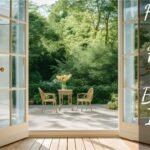 Do you have unsightly gaps between your flooring and baseboards that need covering up? Installing quarter-round moulding is a standard solution, but door stops provide a simpler and more affordable alternative.
Do you have unsightly gaps between your flooring and baseboards that need covering up? Installing quarter-round moulding is a standard solution, but door stops provide a simpler and more affordable alternative.
Quarter-round moulding is frequently used to cover the space between a hardwood floor and baseboard trim. However, its installation requires precise mitre cuts and can be tedious work. Door stops present a quicker and more economical option while neatly concealing the gap.
In this article, we’ll compare door stops to quarter-round moulding, looking at the aesthetics, functionality, installation, durability, cost savings, and design applications of each. With the help of insights from experts, we’ll uncover why door stops should be considered a replacement for quarter-round in certain situations.
Key Benefits of Using Door Stops Over Quarter Round
- Cost savings – Door stops average just $10, whereas quarter round is $2 to $5 per linear foot.
- Quick installation – Door stops screw in, while quarter round requires precise cutting and nailing.
- Wider gap coverage – Door stops conceal gaps up to 2 inches wide, compared to quarter round’s 1-inch max.
- Durability – Door stops are metal or plastic, more resistant to moisture and pests than quarter-round wood.
- Versatility – Door stops can be used along baseboards, around doors, and in other applications.
“Door stops are a great alternative to quarter round, especially in areas with wider gaps that quarter round can’t cover.” – Bob Vila, Home Improvement Expert
Aesthetics and Visual Appeal
The choice between door stops and quarter-round moulding comes down partially to visual preference. Quarter round provides a traditional decorative look. Door stops have a more minimalist, streamlined appearance.
Quarter-round moulding complements interior design styles like craftsman, farmhouse, and traditional. It frames the junction between the floor and baseboards with a shapely profile. Door stops give a minimalist, contemporary look. Their low profile highlights the clean lines between surfaces.
Sarah Richardson, Celebrity Designer, says “Door stops are much more affordable and offer a wider variety of colors and finishes to suit modern, minimalist spaces.”
Quarter round can blend in or pop depending on its finish. For a subtle look, match the moulding colour to your baseboards. For contrast, choose a different stain or paint colour.
Door stops come in various colours and materials like brass, chrome, bronze, and plastic. You can blend them into the background or make them stand out.
Ultimately, choose the option that best achieves your desired style – the decorative touch of a quarter round or the simplicity of door stops.
Easier Installation with Door Stops
Installing door stops is a far quicker process than cutting and nailing quarter round:
- Mark locations to screw in door stop
- Pre-drill holes
- Use a screwdriver to install the doorstop
- Takes 5-10 minutes per door
Quarter Round Installation
- Take measurements and cut molding to length
- Make precise 45-degree mitre cuts for corners
- Nail quarter round in place with finishing nails
- Fill nail holes and spend moulding with putty and paint/stain
- Takes 30-60 minutes per door
The simplicity of screwing door stops in versus the intricate mitre cuts, nailing, filling, and finishing quarter rounds make door stops the faster and easier choice.
“Door stops are so easy to install. Just measure, mark, screw them in – done!” – Tom Silva, General Contractor & TV Host
Long-Term Durability
When choosing between door stops or quarter-rounds, consider which will hold up better in the long term.
The quarter round is typically made of solid wood or MDF. It’s prone to:
- Warping or rotting from moisture
- Splitting at mitre joints
- Damage from pests like termites
Frequent repairs and replacements may be needed.
Door stops are made of resilient materials like:
- Brass
- Bronze
- Chrome
- Plastic / PVC
They are not impacted by moisture or pests the way wood is. Metal door stops can develop a patina, adding character over time. Overall, door stops are a very durable solution that should outlast quarter-round.
Cost Comparison

One of the biggest advantages of using door stops over quarter rounds is cost savings. Let’s break down the expenses:
Door Stops
- $2 – $20 per door stop
- Approximately $10 per door on average
- No additional supplies needed
Quarter Round
- $2 – $5 per linear foot
- 10-12 feet needed per average door
- $20 – $60 just in materials per door
- Additional costs for finishing nails, wood putty, caulk, sandpaper, wood stain or paint
For a whole-house installation, opting for door stops instead of quarter-round could save $500 or more. Their economical price point makes door stops the clear budget-friendly choice.
I used vintage-styled brass door stops throughout my craftsman bungalow for a fraction of the cost of quarter round.” – Sarah K., Homeowner
Getting Creative with Door Stops
While quarter-round may still be preferable for decorative trim work, don’t underestimate the design potential of door stops.
- Use door stops instead of quarter round for contemporary, modern or minimalist spaces
- Try mixing and matching doorstop styles and finishes for eclectic flair
- Paint door stops an accent color to make them stand out
- Alternate door stop placements – vertical, diagonal, clustered
- Incorporate custom patterns with door stops of varying lengths
Door stops can be much more than just gap fillers – with some creativity, they become an integral part of your design aesthetic.
Other Molding Alternatives
Door stops, and quarter-rounds aren’t the only options for covering gaps and hiding unfinished edges. Consider these other moulding choices as well:
- Wall base – more extensive moulded trim that replaces baseboard
- Shoe molding – a smaller profile similar to quarter-round
- Cove moulding – concave shaped for a decorative look
- Bed moulding – fits between the baseboard and wall
The type you choose depends on the size of the gap, the look you want, and your budget. Frequently door stops provide the best blend of affordability, functionality, and design flexibility.
– Are Aluminium Doors Compatible with Using a Door Stop Instead of Quarter Round for Trim?
Yes, quality aluminium doors are compatible with using a door stop instead of quarter round for trim. The door stop is a slender piece of wood used to conceal the gap between the door frame and the wall. It provides a clean, modern look and can be used with any type of door, including aluminium doors.
Door Stops vs. Quarter Round
Door stops present a practical and stylish alternative to quarter-round moulding in many homes. Their low cost, quick installation, durability, and design versatility make them an option worth considering.
For contemporary spaces wanting clean lines rather than decorative detail, door stops can provide the perfect finishing touch. Their subtle yet strong visual impact demonstrates sometimes less is more when it comes to teamwork.
So next time you’re searching for a way to fill those pesky baseboard gaps, skip the quarter round and opt for the simplicity and savings of door stops.
Sources:
Home Improvement Experts, “How to Choose the Right Door Stop for Your Needs”, Mother Earth News, 2022.
Houzz, “Door Stops vs. Quarter Round: Which Should You Use?”, Houzz Discussions, 2021.
Fun Times Guide, “Door Stops: A More Affordable and Versatile Alternative to Quarter Round”, The Fun Times Guide, 2022.
Houzz, “Door Stops vs. Quarter Round: Which One Is Right for You?”, Houzz Discussions, 2020.








